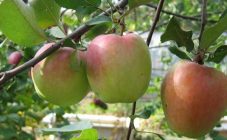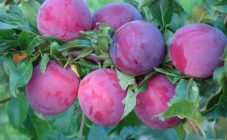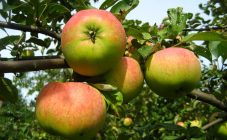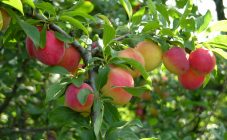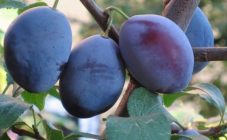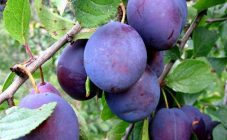A culture such as plum is not a rare guest on Russian garden plots. There are quite a lot of varieties of it, but it is the Manchurian beauty that is especially fond of domestic gardeners.
general characteristics
Plum Manchurian beauty gets its name from the Chinese province of the same name, where it is from. She is also called the Chuya beauty. For the first time they started talking about this variety at the beginning of the last century. The exact information regarding when and by whom exactly the variety was bred has not been preserved. It is believed that the variety appeared as a result of crossing the following varieties:
- Simone;
- Chinese plum;
- Ussuriyskaya plum.
Culture spread on the territory of Russia closer to 1950. This happened thanks to a Russian botanist who lived at that time in the territory of Manchuria. Today, the Chui beauty plum can be found in the European part of Russia, Siberia and the Far East.
Description of the variety
Plum Chuiskaya beauty variety description claims that it tolerates drought well and is able to withstand frosts down to -40 degrees. The plant is resistant to rubella, but it is quite susceptible to damping and moniliosis. Some gardeners consider this plum not a tree, but a shrub, since it grows up to a maximum of 1.8 m. The crown of the tree is oval. The branches are brown-red in color and are covered with light lenticels along the entire perimeter. The bark is often prone to peeling, regardless of how old the seedling is. This plum variety has quite large leaves. They can be up to 13 cm long and 4 cm wide. The foliage is dark green. The plum blooms with white small flowers, the blooming of which occurs earlier than the leaves.
The fruits usually begin to ripen towards the end of summer. The fruit has a round shape, weighs about 15 g. The color of the plum is maroon with a pronounced gray waxy bloom. The peel is tasteless and does not have a high density. The pulp of the fruit is very juicy, yellow-green in color. The fruit tastes sweet and sour. In addition to the above, the fetus has a medium-sized oval bone. It separates easily from the pulp. In this regard, the variety is often used for the manufacture of prunes.
But more often the Manchurian beauty plum cultivated in Siberia is eaten fresh. This is not surprising. The fruits of the culture are juicy, tasty and healthy. 100 grams of Chuy beauty plum contains:
- 7-9 grams of ascorbic acid;
- 8-15 percent sugar;
- 17-27 percent dry matter;
- 0.9-1.7 percent titratable acids;
- 0.37-0.41 percent tannins.
The variety itself is not fertile. For fruit ovaries to appear, a pollinator is mandatory for the culture. To do this, together with the Manchurian plum, other varieties are planted. The Ussuriyskaya plum is especially good at pollination.
Agrotechnics
Experts recommend planting the plum Chuya beauty in the spring, when the weather is already warm enough. In such conditions, the seedlings will sooner take root and take root. While a young tree is growing up, it needs especially close attention. It is at the initial stage of plum growing that the risk of appearing on the trunk is especially high.
The planting site and soil should be given special attention. The soil should be non-acidic, loose and necessarily homogeneous. In no case should you plant a crop in places with a close location of groundwater.
Best of all, the described type of plum takes root on relatively small slopes, where there is enough sunlight, and moisture and snow will not accumulate on the trunk of the plant (they are in most cases the cause of rotting of the root system).
Plants should not be sprayed with any beneficial compounds during its flowering period. At this time, the plum should not even be watered.
You can grow plums in different ways:
- seedlings;
- cuttings;
- layering;
- fruit pits.
Unlike seedlings, the seed must be planted in the ground in the fall. Before doing this, you need to make some simple preparatory activities. In particular, the bone must be thoroughly rinsed and dried well in the sun or on a battery. Then the seed must be removed from the shell and filled with warm water. The seed is then dried and placed in a container with a substrate. Store a tightly closed container in the refrigerator for 4 to 6 months, periodically moistening the soil. Then the prepared planting material is planted in a flower pot with moistened soil. At the bottom of the pot, be sure to put a layer of charcoal or expanded clay.
At the end of planting work, the container will remain covered with polyethylene and placed on the windowsill until sprouts appear. Take care of the sprouts in the same way as for any indoor plants.
Planting the Manchurian beauty in the soil should be carried out at a distance from other trees and at least three meters from other varieties of plums. For the procedure to be successful, a few days before planting, the soil from the future pit is mixed with humus in a ratio of 1:10 and put back. In this case, it is necessary to leave room for the seedling. The pit will need to be large enough - about 0.6x0.6 m. The seedling, when placed in the pit, must be carefully straightened and covered with earth so that the root collar is at least 4 centimeters above the soil surface. After planting, the plant requires abundant watering with settled water.
Few know, but insufficiently moist soil can provoke ovary shedding and a decrease in yield.
In the first winter, the seedling needs mandatory insulation. You can save the culture from frost using non-woven fabric or paper. Alternatively, you can burn the fallen leaves and dig up the ground near the trunk. The described manipulations will not only help the plant not to freeze, but will also reduce the risk of developing rot.
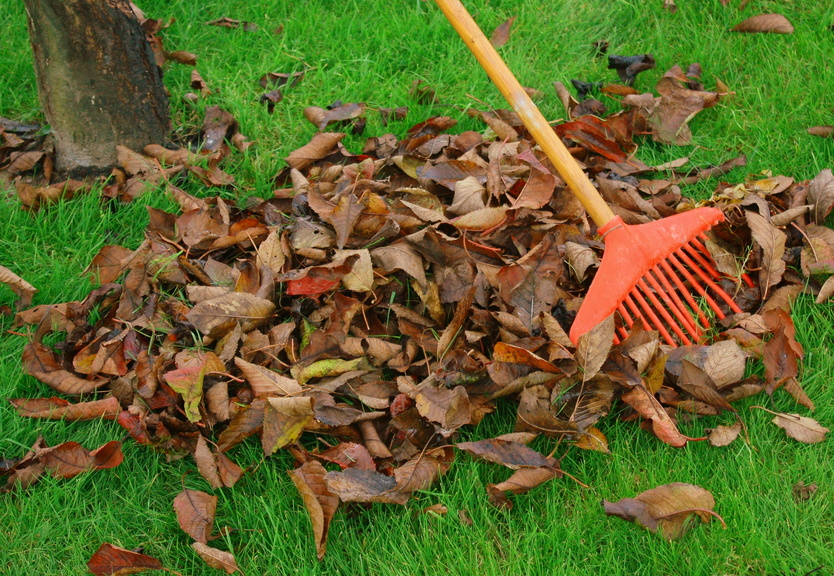
To shelter a plum for the winter, you can burn the fallen leaves and dig up the ground near the trunk
An adult plant, cultivated for several years, is fed with nitrogen fertilizers in the spring. They are necessary to accelerate the growth of new shoots and ensure the vital activity of the tree as a whole.
The Manchurian beauty has strong immunity to most diseases and pests. But a culture may well develop a monolithic burn, which can lead to drying out of the affected parts of the tree and rotting of the fruit. In the fight against this problem, a four percent solution of Bordeaux liquid will be an effective remedy.
Advantages and disadvantages
Like any other culture, the Manchzhurskaya beauty plum has both certain advantages and some disadvantages. The former include:
- early fruiting period;
- frost resistance;
- drought resistance;
- high taste characteristics of fruits;
- low susceptibility to most diseases;
- stable yield indicator.
There are only two downsides:
- the need for a pollinator;
- rapid growth of the crown.
If we talk about the culture in general, it is suitable for growing even in harsh climates. Plum care is not particularly difficult and even the most experienced gardener will be able to do it.





